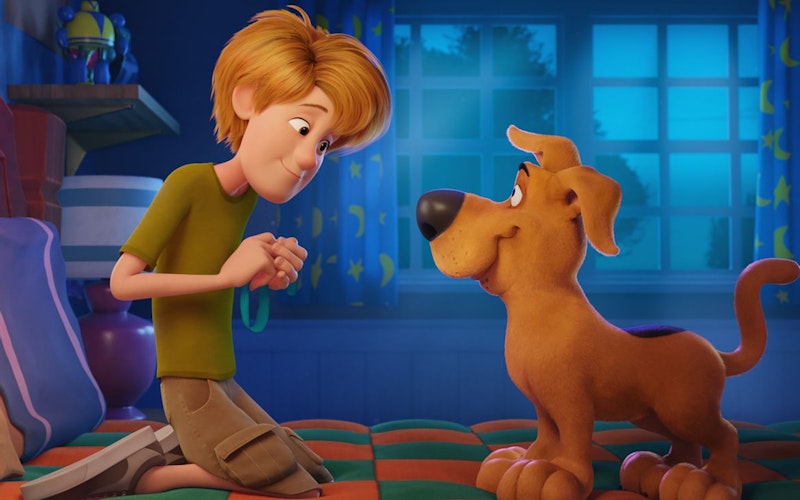
Movies
Fear, Friendship, and Scoob!
Although my 3-year-old son and 8-year-old daughter loved every second of the new animated movie Scoob!, my favorite part arrived 12 minutes in. That’s when we get a recreation of the opening credits of the 1969 cartoon series Scooby-Doo, Where Are You! Set to a punchy cover of the original theme song, we watch Mystery Inc.—Fred, Daphne, Velma, Shaggy, and Scooby—run back and forth through hallways, barely escaping the clutches of glowing ghosts.
Of course, nostalgia partly fuels my enjoyment. Like most monster-obsessed kids of the ’70s and ’80s, I grew up watching Scooby-Doo in syndication. I loved the show’s mix of slapstick humor and creepy creatures. But as a timid child, I especially appreciated the fact that Scooby’s friends never got hurt. No matter how bleak things might have seemed, the amateur sleuths of Mystery Inc. stood together and outsmarted the monster, ultimately revealing it to be nothing more than a guy in a mask. As the police dragged away the perpetrator, he would always bellow some variation of “I might have gotten away with it, too, if it wasn’t for these meddling kids!”
Scoob! harkens back to those early cartoons while updating the formula. Here, celebrity talent judge Simon Cowell (voicing himself) sets the plot in motion when he dismisses Shaggy (Will Forte) and Scooby (Frank Welker, of the original series) as useless members of Mystery Inc.
Scoob! questions the idea of friendship as Scooby and Shaggy, hurt by Cowell’s critique, go on a quest to prove their worth. They team up with insecure superhero Blue Falcon (Mark Wahlberg, possibly doing an impression of Andy Samberg’s impression of Mark Wahlberg), his cyborg dog Dynomutt (Ken Jeong), and his more capable assistant Dee Dee (Kiersey Clemons). Their mission: to keep Dirk Dastardly (a deliciously hammy Jason Isaacs) from finding the skulls of the mythical beast Cerberus and entering Alexander the Great’s lost treasure room.
The adventure tests the bond between Scooby and Shaggy with the revelation that the former is the last descendent of Alexander the Great’s beloved dog. That’s great news to the Blue Falcon team, who fashion Scooby into a superhero. But Shaggy takes it as another sign that his friends have outgrown him.
In a surprisingly emotional sequence, Shaggy watches the Blue Falcon team give Scooby a tech upgrade. As Scooby stands in a clean white room, thumping electronic music plays and blue scanners wash over his body while robot helpers equip him with a supersuit. The robots stop short when they get to Scooby’s dog collar, unable to continue until it’s removed. Recalling that Shaggy gave him the collar as a gift to commemorate their friendship, Scoob looks at his pal for direction. The camera pushes onto Shaggy, who acknowledges Scooby’s dream to become a superhero and gives a defeated nod. Scooby removes the collar and completes his transition, but the camera cuts back to Shaggy. Director Tony Cervone and his team of animators capture the fear in Shaggy’s eyes as he contemplates something scarier than any monster he’s ever faced: a future without his best friend.
Scoob! questions the idea of friendship as Scooby and Shaggy go on a quest to prove their worth.
Parents might be surprised to find such heavy themes in a kid’s movie. But I’m reminded of the defense of fairy tales G. K. Chesterton presents in Tremendous Trifles. “Fairy tales . . . are not responsible for producing in children fear, or any of the shapes of fear; fairy tales do not give the child the idea of the evil or the ugly; that is in the child already, because it is in the world already,” writes Chesterton. Instead, he argues, fairy tales give children "a series of clear pictures to the idea that these limitless terrors had a limit, that these shapeless enemies have enemies in the knights of God, that there is something in the universe more mystical than darkness, and stronger than strong fear.”
As a Christian writer, Chesterton likely had passages such as 1 John 4 in mind when talking about something stronger than fear. “God is love,” the epistle declares. “Whoever lives in love lives in God, and God in them.” When we love like Jesus, we overcome fear because there “is no fear in love.” Instead, “perfect love drives out fear.” The end of the passage includes an instruction: “Anyone who loves God must also love their brother and sister.” Thus, the love that puts limits on limitless terrors manifests when we love one another. The perfect love of God becomes real in our friendships.
Although they do so in a childlike manner, classic Scooby-Doo stories illustrate this point. Friends can defeat any monster together. No matter how menacing the terror might appear, the gang supports one another to reduce the monster to a crotchety grouch in a silly mask.
Scoob! demonstrates this with a scene that retells the first childhood (er, puppyhood) meeting of Mystery Inc. On Halloween, little Shaggy and Scooby lose their candy to a couple of bullies, who toss the treats inside the local haunted house. Shaggy and Scooby are too scared to go in, but that’s when Fred, Daphne, and Velma show up and vow to face the ghost inside together. The camera underscores the creep factor as it pans up along the house’s gray exterior, but that image is then contrasted with the five friends walking side by side. We know they’ll drive out each other’s fear.
Well, most of us know that. My 3-year-old, watching his first Scooby cartoon ever, shuddered during the sequence. But that’s when my 8-year-old, a Scooby veteran, held her brother’s hand and told him there was nothing to fear. She sat beside him and comforted him—a lesson she may have never learned if it weren’t for those meddling kids.
Topics: Movies